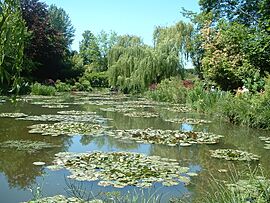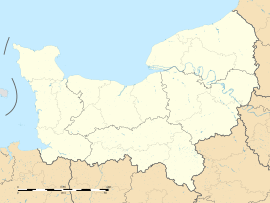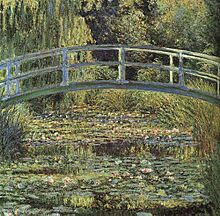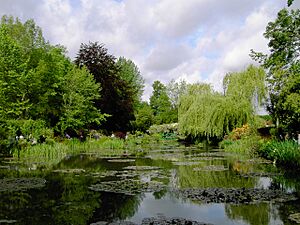Giverny facts for kids
Quick facts for kids
Giverny
|
|
|---|---|

Water lilies in the famous garden of artist Claude Monet in Giverny. He painted his well-known Water Lilies series here.
|
|
| Country | France |
| Region | Normandy |
| Department | Eure |
| Arrondissement | Les Andelys |
| Canton | Vernon |
| Intercommunality | Seine Normandie Agglomération |
| Area
1
|
6.46 km2 (2.49 sq mi) |
| Population
(2022)
|
448 |
| • Density | 69.35/km2 (179.6/sq mi) |
| Time zone | UTC+01:00 (CET) |
| • Summer (DST) | UTC+02:00 (CEST) |
| INSEE/Postal code |
27285 /27620
|
| Elevation | 10–139 m (33–456 ft) (avg. 17 m or 56 ft) |
| 1 French Land Register data, which excludes lakes, ponds, glaciers > 1 km2 (0.386 sq mi or 247 acres) and river estuaries. | |
Giverny (pronounced zhee-vehr-NEE) is a small village, or commune, in the northern part of France. It is located in the Normandy region, about 80 kilometers (50 miles) from Paris. The village sits on the bank of the famous Seine river.
Giverny is best known as the home of the famous artist Claude Monet. He created a beautiful garden and house there, which inspired many of his paintings.
Many American artists who painted in the Impressionist style also moved to Giverny. They were inspired by the beautiful landscapes and by Monet's work. Today, you can visit the Museum of Impressionism Giverny and the Hôtel Baudy, which was a popular spot for artists.
Contents
The History of Giverny
People have lived in the area of Giverny since the Neolithic period, also known as the New Stone Age. Archaeologists have found items from the time when the Gallo-Romans lived there, thousands of years ago. In ancient times, the town was called "Warnacum."
For centuries, the people of Giverny grew grapes for a living. The village church, dedicated to Sainte-Radegonde, was first built during the Middle Ages.
For most of its history, Giverny was a small, quiet village. In 1883, when Claude Monet first moved there, only about 300 people lived in Giverny. Since Monet's home and gardens were restored and opened to the public, the village has become a popular place for tourists to visit.
Claude Monet's Life in Giverny

The famous artist Claude Monet first saw Giverny from a train window and decided he wanted to live there. He rented a house with some land around it. By 1890, he had earned enough money from his art to buy the property.
Monet then began to design the amazing gardens he had always dreamed of painting. His gardens at Giverny are the subject of some of his most famous works of art.
Monet's Famous Gardens
Monet's property had two main parts.
- The Clos Normand was a flower garden right in front of the house. It was filled with colorful flowers and plants growing over beautiful archways.
- The Water Garden was inspired by Japanese art. Monet created a pond by redirecting a small river. This garden featured a Japanese-style bridge, weeping willows, and beautiful flowers like wisterias and azaleas. Most famously, it was home to the water lilies that he painted over and over again.
The Giverny Art Colony
Starting around 1887, many American artists who painted in the Impressionist style came to Giverny. They were attracted by the beautiful scenery and the chance to be near the great artist, Claude Monet. Some of these artists included Willard Metcalf, Louis Ritman, and John Leslie Breck.
At first, many artists just visited for the summer, but soon they started staying all year. One American painter, Theodore Earl Butler, even married Monet's stepdaughter, Suzanne Hoschedé, in 1892.
Another American artist, Frederick Carl Frieseke, lived next door to Monet from 1906 to 1919. His style of painting was called Decorative Impressionism. This term was used to describe the work of other American painters in Giverny as well.
The art colony in Giverny was a lively community for many years, but it mostly came to an end when World War I began in 1914.
What to See in Giverny Today
Today, Giverny is a popular destination for art lovers and tourists.
- Monet's House and Gardens: After Monet's death, his son gave the property to a French art academy. It was carefully restored and opened as a museum in 1980. You can walk through Monet's colorful house and see his collection of Japanese art. The gardens have been replanted to look just as they did when Monet was alive.
- Museum of Impressionism Giverny: This museum is dedicated to the history of Impressionism. It shows how the art style developed in Giverny and the nearby Seine river valley.
- Hôtel Baudy: This was once a hotel and restaurant where all the artists in Giverny would meet. It is still a café and restaurant today, decorated to look like it did in the past.
See also
 In Spanish: Giverny para niños
In Spanish: Giverny para niños





